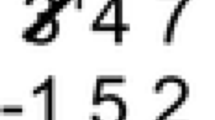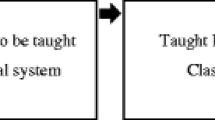Abstract
The use of the historical development of mathematical concepts to inform current teaching and learning has been a debatable process. Historically, in Indian mathematics (and Mayan), a study of large numbers seems to have provided the impetus for the development of a place value number system. Present day students do not have to create a number system, but they do need to understand its structure in order to develop number sense and operations. In order to investigate the value of this approach we considered the use of a combination of historical development of large numbers, number systems and modeling with concrete materials as a way of enhancing students’ knowledge and understanding of place value structure. Additionally, we also looked at place value in different number bases and linked multiple representations in an attempt to strengthen understanding of the structure of the number system. The results suggest that this historical and concrete approach helped students to gain competence in naming and using large numbers, and in understanding positional notation through exponentiation, to the extent of generalizing it to other bases.
Similar content being viewed by others
References
Bag, A. K. (2003). Need for zero in the numerical system in India. In A. K. Bag & S. R. Sarma (Eds.),The Concept of Sunya, (pp. 159–169.). New Delhi: IGNCA, INSA á Aryan Books International.
Barbin, E. (2000). Integrating history: Research perspectives. In J. Fauvel & J. van Maanen (Eds.),History in mathematics education: The ICMI study (pp. 63–90). Dordrecht, The Netherlands: Kluwer.
Barnard, T., & Tall, D. O. (1997). Cognitive units, connections and mathematical proof. In E. Pekhonen (Ed.),Proceedings of the 21st annual conference of the International Group for the Psychology of Mathematics Education (Vol. 2, pp. 41–48). Lahti, Finland: PME.
Barton, B. (2007). Commentary from a mathematics educator.Educational Studies in Mathematics, 66, 185–201.
Datta, B. B., & Singh, A. N. (2001).History of Hindu mathematics: A source book. Parts I and II. New Delhi: Bharatiya Kala Prakashan.
DEST (2004).Understanding place value: A case study of the Base Ten Game. Report of a project funded under the Australian Government’s Numeracy Research and Development Initiative and conducted by the Association of Independent Schools of South Australia. Canberra: Author.
Dienes, Z. P. (1960).Building up mathematics. London: Hutchinson Educational.
Fauvel, J., & van Maanen, J. (Eds.) (2000).History in mathematics education: The ICMI study. Dordrecht, The Netherlands: Kluwer.
Fischbein, E., Tirosh, D., & Hess, P. (1979). The intuition of infinity.Educational Studies in Mathematics, 10, 3–10.
Gupta, R. C. (1987). One, two, three to infinity.The Mathematics Teacher:Official Journal of the Association of Mathematics Teachers of India, 23 (4), 5–12.
Gupta, R. C. (1995). Why study history of mathematics?Bulletin of the Indian Society for History of Mathematics, 17, 1–4, 10–28.
Gupta, R. C. (2003). Technology of using Sunya in India. In A. K. Bag & S. R. Sarma (Eds.),The Concept of Sunya. New Delhi: IGNCA, INSA, Aryan.
Hattie, J. A., Brown, G. T. L., & Keegan, P. (2005).asTTle V4 Manual 1.1. Auckland NZ: The University of Auckland.
Hewitt, D. (1998). Approaching arithmetic algebraically.Mathematics Teaching, 163, 19–29.
Irwin, K., & Burgham, D. (1992). Big numbers and small children.The New Zealand Mathematics Magazine, 29 (1), 9–19.
Joseph, G. G. (2000).The crest of the peacock: Non-European roots of mathematics. Harmondsworth: Penguin.
Joseph, G. G. (2002). The enormity of zero. In A. Ramakrishnan (Ed.),The Mathematics Teacher: Official Journal of The Association of Mathematics Teachers of India,38(3 á 4).
Katz, V. J. (2001). Using the history of algebra in teaching algebra. In H. Chick, K. Stacey, J. Vincent & J. Vincent (Eds.)The future of the teaching and learning of algebra: Proceedings of the 12th ICMI study conference (Vol. 2. pp. 353–359). Melbourne, Australia.
Katz, V. J. (2007). Stages in the history of algebra with implications for teaching.Educational Studies in Mathematics, 66, 185–201.
Mason, J. (1996). Expressing generality and roots of algebra. In N. Bednarz, C. Kieran & L. Lee (Eds.),Approaches to algebra: Perspectives for research and teaching (pp. 65–86). Dordrecht, The Netherlands: Kluwer.
Mason, J. (2008). Doing ≠ construing and doing + discussing ≠ learning: The importance of the structure of attention.Proceedings of ICME-10, Copenhagen, http://www.icme10.dk/proceedings/pages/regular_pdf/RL_John_Mason.pdf
Mason, J., Graham, A., & Johnston-Wilder, S. (2005).Developing thinking in algebra. Milton Keynes, UK: The Open University.
Ministry of Education (2007).Mathematics and statistics. The New Zealand curriculum. Wellington, New Zealand: Learning Media.
Puig, L., & Rojano, T. (2004). The history of algebra in mathematics education. In K. Stacey, H. Chick, & M. Kendal (Eds.),The future of the teaching and learning of algebra: The 12th ICMI study (pp. 189–223). Dordrecht, The Netherlands: Kluwer.
Radford, L. (1996). Some reflections on teaching algebra through generalisation. In N. Bednarz, C. Kieran & L. Lee (Eds.),Approaches to algebra: Perspectives for research and teaching (pp. 107–112). Dordrecht, The Netherlands: Kluwer.
Radford, L. (2000). Historical formation and student understanding of mathematics. In J. Fauvel & J. van Maanen (Eds.)History in mathematics education: The ICMI study, Dordrecht, The Netherlands: Kluwer.
Sen, S. N. (1971). Mathematics. In D. M. Bose, S. Sen, & B. V. Subbarayappa (Eds.),A concise history of science in India (pp. 136–209). New Delhi: Indian National Science Academy.
Sfard, A. (1995). The development of algebra: Confronting historical and psychological perspectives.Journal of Mathematical Behaviour, 14, 15–39.
Srinivasaiengar, C. N. (1967).The history of ancient Indian mathematics. Calcutta: World Press.
Tall, D. O. (1980). The notion of infinite measuring number and its relevance in the intuition of infinity.Educational Studies in Mathematics, 11, 271–284.
Tall, D. O. (2001). Natural and formal infinities.Educational Studies in Mathematics, 48 (2&3), 199–238.
Thomas, M. O. J. (2008). Developing versatility in mathematical thinking.Mediterranean Journal for Research in Mathematics Education, 7 (2), 67–87.
Thomas, N. (2004). The Development of structure in the number system. In M. J. Hoines & A. B. Fuglestad (Eds.),Proceedings of the 28th annual conference of the International Group for the Psychology of Mathematics Education (Vol. 4, pp. 305–312). Bergen, Norway: Bergen University College.
Tzanakis, C., & Arcavi, A. (2000). Integrating history of mathematics in the classroom. In J. Fauvel & J. van Maanen (Eds.),History in mathematics education: The ICMI study (pp. 201–240). Dordrecht, The Netherlands: Kluwer.
Ursini, S. (2001). General methods: A way of entering the world of algebra. In R. Sutherland, T. Rojano, A. Bell, & R. Lins (Eds.)Perspectives on school algebra (pp. 13–36). Dordrecht, The Netherlands: Kluwer.
Warren, E. (2003). The role of arithmetic structure in the transition from arithmetic to algebra.Mathematics Education Research Journal, 15 (2), 122–137.
Zazkis, R. (2001). From arithmetic to algebra via big numbers. In H. Chick, K. Stacey, J. Vincent, & J. Vincent (Eds.),The future of the teaching and learning of algebra, The Proceedings of the 12th ICMI study conference (Vol. 2, pp. 676–681). Melbourne, Australia.
Author information
Authors and Affiliations
Rights and permissions
About this article
Cite this article
Nataraj, M.S., Thomas, M.O.J. Developing understanding of number system structure from the history of mathematics. Math Ed Res J 21, 96–115 (2009). https://doi.org/10.1007/BF03217547
Issue Date:
DOI: https://doi.org/10.1007/BF03217547




